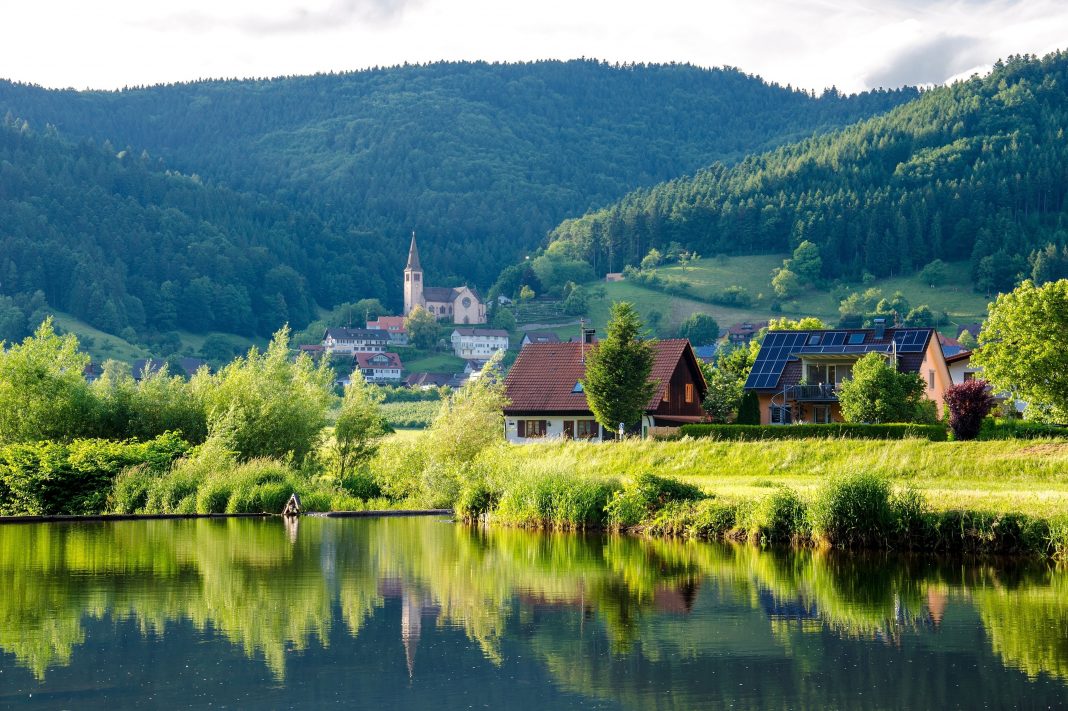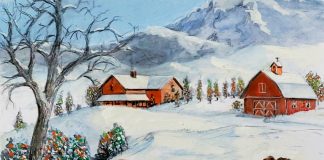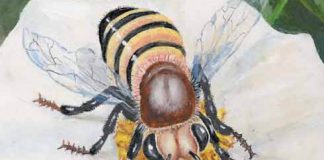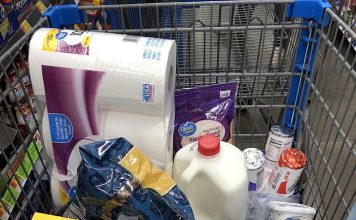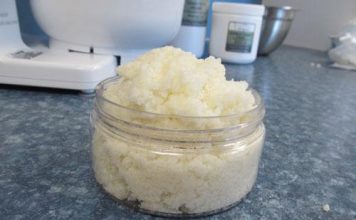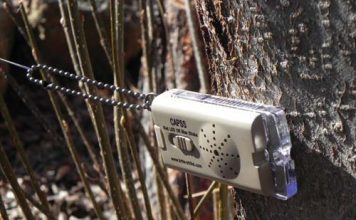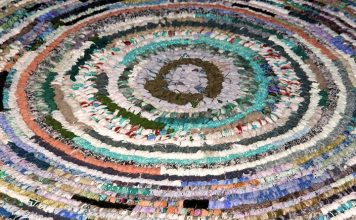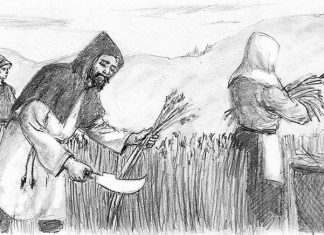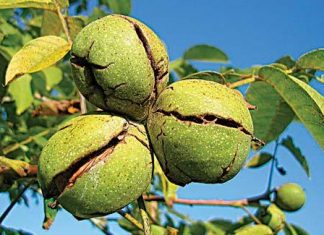| Issue #85 • January/February, 2004 |
When Nate and MaeCile Brown amble down the main street of Thermopolis, Wyoming, everybody recognizes them. They’re old friends, honored citizens, and local characters. They can’t go 25 steps without somebody wanting to stop and say howdy.
Now, consider that Nate and MaeCile actually live 40 miles outside of town. That should give you an idea of what a big, friendly neighborhood Thermopolis is.
For that matter, most of Wyoming is a friendly neighborhood. There’s a saying that it’s the only state where, if you dial a wrong number, you’ll probably reach somebody you know.
Ninth largest state in the nation, Wyoming has fewer than 500,000 residents. Antelope outnumber the humans. There’s one elk for every four people, which means there are far more elk than there are hunters to stalk them. There are no big urban areas in whole the state, unless you count the 50,000 citizens of Cheyenne or Casper as serious city folk.
This is a state where drivers wave at each other on major highways a hundred miles from home. Break down 35 miles from the nearest gas station? Don’t panic. The first people to come along will almost certainly help you. It’s not just neighborliness; it’s survival of the species in an environment of sagebrush, alkalai flats, howling winds, and brutal winters.
The PR flack who came up with the current Wyoming tourist motto”Like No Place on Earth”got it right. To most civilized folks, Wyoming is as foreign as the moon.
In the middle of this great (and sometimes strange) state, lies the little city of Thermopolis. It, too, is a world of its own. Fortunately it’s a world that has all of Wyoming’s virtues without some of the worst harshness.
|
Thermop, as the locals call it, snakes along the Big Horn River in a pleasant, sheltered, red-rock valley just northwest of the center of the state. With an elevation of 4,300 feet and a population of 3,200, Thermop fits another Wyoming maxim: Never trust any town whose population is higher than its elevation. Thermopolis is trustworthy.
Thermopolis is the county seat of Hot Springs County, the second least-populated county in the state with just 4,800 people in 2,004 square miles.
Town and county sit in the most temperate portion of the state, the Big Horn Basin. “Temperate” and “Wyoming climate” might seem like an oxymoron to anybody who knows the high, howling plains along I-80. But Thermopolis has its own mini-climate: far less windy, generally warmer, and less blizzard-prone than the surrounding country. The average temperature in January is 22 degrees, and in July, 73. The sun shines 320 days per year. By Wyoming standards, Thermopolis is close to heaven.
It’s even closer to heaven thanks to something sulphuric under the ground.
Thermopolis (from the Latin for “hot” and Greek for “city”) grew around some of the world’s largest mineral hot springs. Water gushes out of the ground at 127-132 degrees and more than 1.3 million gallons a day. Some of the water channels into a complex of swimming pools, soaking pools, steam rooms, and waterslides in Hot Springs State Park, just outside the downtown business area. More hot water courses over travertine terraces into the Big Horn River, where mineral deposits create a colorful frozen waterfall of stone.
When you think of fabulous big hot springs and a complex of developed spas, you might think: expensive. Or touristy. Forget that impression!
The tourists are there, for sure, especially on holiday weekends or during spring break. But they’re largely invisible. They’re at the park or in one of Thermop’s many museums. They haven’t driven prices sky high. They haven’t turned the town into a mass of trinket-peddlers. And they haven’t moved in to stay, bringing outsider yuppie values with them. In short, unlike many other places with special gifts of nature, Thermopolis hasn’t been ruined for those who live there.
One of the little miracles of Thermopolis is that it’s remarkably affordable. The median household income is just under $30,000. The cost of living is slightly under Wyoming’s average, which is well under the national average. A very nice three-bedroom, two-bath house can be had for $90,000. A livable house is often as little as $50,000. Fixers can go for $23,000.
The hot springs businesses in the park are remarkably local-friendly, too. At the TeePee Spa you can swim, soak, slide, and steam every day all year for a $132 annual membership (add a second family member for $80). Or join its rival, the Star Plunge, for $120 per person. Both spas have discounts (sometimes freebies) for children.
If those prices are still too rich, a tiny state government bathhouse sits between the big privately operated spas. The state lets you soak for free, although the attendants chase you out after a mere 20 minutes.
On weekday mornings you may find you have the waters all to yourself. Hint: The best swimming and soaking is in the dead of winter, when snow falls on your nose.
Horse town U.S.A
Thermopolis is also known for horses.
This is where Nate and MaeCile Brown come in. They run one of many cattle-driving, horse-raising, horse-training, purely Wyoming businesses in Hot Springs County. He, an old cowboy born in 1921, still trains horses and leads grueling cattle drives up into the mountains. She, a young Harvard Ph.D candidate, helps run HorseWorks Wyoming, rides the trails, and cooks some of the best trail food a tired cowperson has ever devoured. They take tourists on cattle drives. But if you’re looking for a cushy dude-ranch experience, look someplace else. This is hardcore Wyoming, with long days of riding and accommodations in tents, teepees, or (for the lucky few) genuine sheepherder’s wagons.
Bill and Carole Smith have a ranch whose annual sale of quarter horses brings customers from around the nation and can generate very un-Wyominglike prices for stock. (You can get a pretty good horse in Hot Springs County for $1,500-$2,500; on the other hand, arena-broke geldings have sold for more than $80,000 at the Smith’s spring sale.)
The biggest horse-related event is the Outlaw Trail Ride. Dudes and experienced horse-riders from all around the U.S. come every year to spend a week riding from Butch Cassidy’s famous Hole in the Wall (about 100 miles east of Thermopolis) back into town, often partying up a storm along the way.
Living there
But that’s for the tourists and the businesses who rely on horse leasing, tack sales, and feed. What if you want to live in Thermop or its big “neighborhood” in rural Hot Springs County?
Real estate prices in town, as you’ve seen, are pretty reasonable. Finding your ideal, affordable place in the country is harder for several reasons.
First, more than 70 percent of Hot Springs County is government-owned and off-limits to development. (This is a plus as well as a minus; much of this government land is open to hunting, plinking, snowmobiling, hiking, horseback riding, and ATV trekking.)
|
Second, Wyoming’s monumental ranches are still largely intact, not being subdivided. If you want a $1.5 million country retreat, Wyoming’s got ’em and Hot Springs County has a few. If you just need 40 acres and a mule, that takes more looking.
Third, state law makes it difficult to subdivide below 35 acres, so five-to-10-acre mini-ranches are hard to find. Fortunately, just north and west of Thermopolis there’s nice land, often with irrigation water, in parcels ranging from five acres to … whatever you want.
Sample prices from Hot Springs County’s biggest real estate broker, Matt Brown (http://server1.realestate-wy.com/): 4.396 acres near town with city water and utilities, $24,900; 430 remote acres, $161,250; 122 acres with views and highway frontage $65,000.
Unirrigated, most Wyoming lands, even in this relatively benign region, are sagebrush deserts, fit only for grazing livestockand around here, they think in terms of “acres per head” rather than “head per acre.” Irrigated, however, these lands can produce alfalfa, corn, sugar beets, and other hardy crops.
Water can be a problem, as you might imagine. Thermopolis town water is pretty fair by Wyoming standards, and purified water is dispensed from machines at the town’s two grocery stores. Water found outside of town, however, is fit mostly for animals and crops. In most places, it takes very deep, very expensive drilling to get human-potable water. As a consequence, you often see pickup trucks with huge white tanks in their bedsranchers hauling town water to their homesteads for drinking and washing. Some install reverse osmosis water systems.
Here’s some good news to counteract the bad news on drinking water. Outside of town limits, there are no building permits required. As county planner Alex Fitz told me, “We don’t have a lot of rules and regulations out in the county right now.” And there’s no plan to add them.
Most of the county is zoned agricultural. It requires an application to the county planner’s office to change a parcel to residential or industrial. However, parcels of ag land have a two-acre allowance for a homestead. So in almost all cases you can build freely.
Outdoor recreation
A few years ago, Sports Afield named Thermopolis the best outdoor recreation area in Wyoming. In a state famed for outdoor activities, that’s saying something. You can hunt for bear, antelope, deer, or elk, go trout fishing, raft through rapids, water ski, ride horseback, snowmobile, go four-wheeling, target shoot, canoe, rock climb, play golf, view ancient petroglyphs, or hike, all within half an hour of downtown.
Just south of town, the highway plunges into the Wind River Canyon, 15 miles of spectacular rock walls (some as high as 2,500 feet) with the river rushing at their roots. You emerge from the canyon at Boysen Reservoir, the town’s water source and an easy spot for camping, swimming, boating, or barbecuing.
But some of us would rather stay indoors, read, and sip a nice, civilized latte or mocha. Well, don’t think Thermop is only for the hearty. Stop in at the Storyteller, a world-class book store. JoAnne or Gerald Gerber will make you the coffee drink, chai, or ice rage of your choice, and you can enjoy it while sitting on a comfortable sofa reading a newspaper or gossiping with the locals. The Storyteller is to modern Thermop what the pot-bellied stove at the general store was to Thermopolitans of 100 years ago.
All in all, Thermop has a nice little downtown with several good, inexpensive restaurants and specialty stores. It has too many empty storefronts (like so many rural towns), but enough open businesses to get you the necessities and a few small luxuries. (No Wal-Mart though, and only a couple of fast-food chain outlets. Riverton, 50 miles south, or Cody, 83 miles northwest, are where you go to shop. Or Billings, just under 200 miles away in the no-sales-tax land of Montana.)
Work, travel, and taxes
Wyoming has always had a boom-and-bust economy based on the fluctuation of oil, gas, and mineral prices. Hot Springs County isn’t immune. Even with the tourism, livestock businesses, and dinosaur-digging, its economic fate rises and falls with oil prices. However, of the area’s six biggest employers, only one is oil-related. (The others are the school system, the hospital, the Holiday Inn in Hot Springs State Park, a retirement home, and a school for retarded children.) Thermop has more doctors per capita than almost any place in the U.S. No “rural health care crisis” here. This abundance of medical services is one gift of the hot springs, which originally attracted people because of their curative, rather than recreational, properties. If your skills are in the medical field, Thermop may have good employment for you.
For anybody who wants to move in and earn a living (particularly those who want to be self-employed), Thermopolis has some big plusses and big minuses:
- Several forms of high-speed internet are available at reasonable rates, including DSL and wireless.
- Thermop sits at the intersection of two main state highways, Hwy. 20, which goes north to Worland (45 minutes) and South to Riverton (one hour), and Hwy. 120, which goes to Cody (90 minutes).
- It’s 124 miles to the nearest interstate on-ramp (in Casper) and 179 miles to I-90 (just west of Billings, Montana). This is a bad thing for work, but most of the locals like it just fine. Keeps the riff-raff out, so they say.
- Thermopolis has a good general aviation airport with a 4,800-foot runway and 24-hour fuel station. Commercial airports are nearby in Worland, Riverton, and Cody.
- Contrary to the perception of those who think “flyover country” is populated by ignorant rubes, Wyoming has the third best-educated citizenry in the country. Ninety percent of Wyoming’s high school students graduate. Seventy-seven percent of the Hot Springs County population, including old timers, has at least a high school degree. This makes for a smart workforce. And the Wyoming climate and spirit of independence make for a hardworking and rugged workforce.
|
It’s also a workforce that doesn’t get squeezed dry by taxes. Wyoming has no corporate or personal income tax, no business inventory tax, and low property taxes. The state sales tax rate is 4 percent, with counties free to add up to 2 percent more. (Hot Springs County sales tax is 5 percent.) Vehicle license taxes aren’t rock bottom, but they’re reasonable for a state that has to pay for long highways stretching between very small population centers.
Wyoming ranks 43rd among the 50 states in state tax burden. It ranks 10th once you add in federal taxes. However, most of those federal taxes are mineral-extraction taxes, paid not by the residents but by big out-of-state mining companies.
There’s been a recent attempt to “reform” the state tax system (read “impose an income tax”). So far the effort has gone nowhere.
Thermopolis and the Wyoming way
Culture is an intangible thing. It’s best expressed in those Wyomingites who stop to help on the highway and things of a similar nature. So instead of trying to describe it, let me just give some examples of the culture in Thermopolis and Hot Springs County.
- In the park, just behind the hot springs, roams a small buffalo herd. “Small” isn’t a word that goes well with buffalo. These are behemoths. Signs at the entrance to their pasture say “Buffalo are dangerous.” But that’s the extent of the “protection” the state government gives you. There’s not a fence, a wall, a ditch, or even a charged wire between you and the bison. If you’re stupid enough to go walking up to a bull buffalo in mating season and get yourself gored, well your genes were probably just muddying up the pool anyway. In other words, the Safety Nazis haven’t taken over Wyoming and aren’t about to. Your own common sense still has value in this state where sense can save your life and foolishness can kill you.
- I have a friend in Thermop who wears a five-shot .22 North American Arms revolver on his belt buckle. Everywhere he goes, people ask him, “Is it real?” Store clerks, waitresses, bank tellers, touriststhey all want to know. Not a single person in Wyoming has been upset to learn that yes, his belt buckle gun is a genuine working firearm. He’s even worn it into the county courthouse, where it’s technically illegal, and gotten no hassle.
- Wyoming, including Hot Springs County, is the only state where a traffic jam consists of a herd of cattle being driven down the road. No kidding. The entire state is so traffic-free that 5 p.m. will become just another unremarkable time of day to you.
- Less than an hour north of Thermopolis, in Big Horn County, the sheriff has a written agreement with the federal government: federal agents cannot and do not operate in his county without his consent. The Hot Springs County sheriff has no such agreement, but western sheriffs, including this one, are increasingly inclined to use their authority to halt the worst federal violations.
- A huge find of dinosaur bones was made in the hills just east of Thermopolis 21 years ago. Instead of coming up with a scheme to have the entire, enormous dig taken over by a government-funded university, Thermopolis did it the old-fashioned American way (despite the fact that the genius behind the plan was Swiss): Burkhard Pohl helped discover the fossils, bought the ranch where they were found, moved his entire family to the U.S., and opened the privately funded Wyoming Dinosaur Center, which has become a major asset both to Thermopolis and to paleontology.
In short, Wyoming is for hardy people whose independent streak is as wide as the sagebrush plains. It doesn’t matter where you’re from or how long you’ve been there; it’s who you are that counts. Wyoming is a living example of the old west meeting the new and preserving the best of both. It’s a state of mind as well as a state of the nation. It’s not always an easy place to live, but in Thermop you get the wonderful Wyoming Way without quite so much of the hardship.
Photo credit: Richard Coffinberry, RAC Digital Photography, Thermopolis, WY, rac@trib.com


